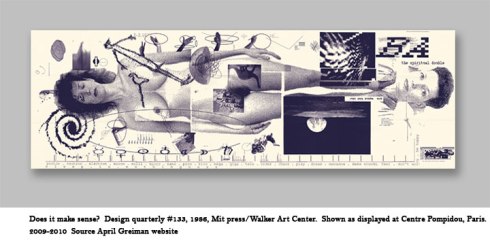…Greiman saw Design Quarterly #133 as an opportunity not only to present her digital work but to ask a larger question of the work and the medium: Does it make sense? Reading Wittgenstein on the topic, she identified with his conclusion: “It makes sense if you give it sense.” She says, “I love this notion which exists in physics as well—that the observer is the observed, and the observed is the observer… Excerpt From April Greiman AIGA biography

Source: Artist’s Website.
After covering all the chapters of Megg’s History of Graphic Design (8), it seems to me that the mind is the only tool that hasn’t change for graphic designers. One of the graphic designer that strikes me for the continuous evolution of her designs is April Greiman. Her work have gravitated in an evolving world of technology, imagery, typography. More than evolving, the previous trio of elements was adapted by the artist to different situations, to the point of seeing herself as a “trans-media artist” instead of a graphic designer.
In the early 70’s, Greiman went for Graduate School to the Basel School of Design, where she studied deeply the International Style and was also introduced to the New Wave typography by his progenitor, Wolfang Weingart. Back in the US she was the one popularizing d New Wave here. She experimented with the arrange of the page, adding a 3Dimensional view, integrating the whole space and making a more personal , more unique experience for the viewer with the piece.
When Greiman became head of the Graphic Design Department at the California Institute of the Arts (1982), she successfully lobbied to change the department name to Visual Communications, as she felt the term “graphic design” would prove too limiting to future designer.”(5)
Her remarkable collaborations with architects are examples of a modern balance between urban spaces and art. These are reflected on her projects for AOL, Time Warner, Amgen, Dosa 818, PacTel, Amgen, Accenture Tower, US West, Sci –Arc and the US Postal Office.
Together with her studio “Made in Space”, she founded ”Gremanski Labs”, which is considered in her own words,” a laboratory dedicated to experiment and exploration.” Starting with her 1987 Design Quarterly #133 magazine to today public art commissions for the city of Los Angeles, Greiman hasn’t stop searching new ways to present her art. Her work expanded beyond works on paper to a combination of graphic design, video, computer graphics, architecture and environment. (2)

During a talk of April Greiman at the Southern California Institute of Architecture titled “Think about What You Think About” in 2009, she finished the talk with questions she said she continuously ask herself. Some of them are:
1. Am I taking enough risk?
2. Do I explore the unknown?
3. Can people learn and grow from what I make?
Greiman uses any opportunity to work on things that interest her: spaces, colors, technology, and during the process of creating , she, also re-invent herself, shares her emotions and brings to the public a strong intellectual element.
After seeing and studying her work and the work of many other designers like Paula Scher, Karel Martens, Ruedi Baur, all mentioned on Megg’s History of Graphic Design, I am very happy to see how the field of “graphic design” have expanded immensely for those with strong foundations, creative minds and eager to explore collaborations with other professions. It is also very interesting to see how all the above designers have a strong typography foundation and now, they are working on environmental/urban projects among others.
With the challenges of the twenty-first century, what fits better our career “Visual Communication” or “Graphic Design”?
References
1. http://www.sciarc.edu/lectures.php?id=1505
2. http://www.slideshare.net/fkgraphicdesign/presentation-april-greiman#btnNext
3. http://madeinspace.la/
4. http://drive-byshooting.com/editions.html
5. http://en.wikipedia.org/wiki/April_Greiman
6. http://www.citrinitas.com/history_of_viscom/computer.html
7. http://designtaxi.com/article/100192/Women-in-Design-II/
8. Meggs, P.B., Purvis, A.W. Megg’s History of Graphic Design,Wiley & Sons, fifth ed., 2012



Hello, can I ask that who prepared this? I want to make reference in my thesis
Alejandra Chaverri, photographer, Graphic Designer